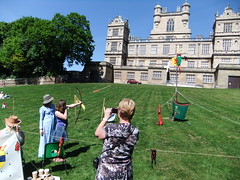
Archery is a sport of skill, tactics and intellect. It requires rigorous practice and a lot of insight. But apart from that, a very important factor is the quality of equipment used by an archer.
Mainly, two kinds of equipment are needed, a bow and arrows. Arrows are often attached with fletchings. Bows can be made of different material and are of varied kinds, a bow using low quality wood will have structural strengths. Bows are differentiated by their limbs, their shape when unstrung and the kind of bow string they have. Similarly, arrows have varied makes too.
The most commonly seen arrow would have a shaft. The front end of this shaft would have an arrow head. The rear end will have fletchings along with a nock. Most commonly aluminium alloys, wood, carbon fibre, fibreglass or other composite substances are used to make shafts. Wooden arrows tend to be warping prone. Though fibreglass arrows tend to be brittle, they have the quality of easy production in accordance with any given specification. Aluminium shafts have the quality of flat trajectories and high speed due to their straight shape and light weight this made them extremely popular with archers in the later half of the 20th century. The 1990s saw the advent of carbon fibre arrows, they are lighter in weight, flight and flatness as compared to aluminium arrows. The most popular kinds of arrows used nowadays in tournaments and Olympic events are made of composite materials. The most commonly used is the Easton X 10 and A/C/E.
The primarily functional component of the arrow is the arrow head. Though the sharp tip of the shaft can be used, many archers prefer using separate and specially made arrow heads. These are made of hard substances like stone, metal or very finely crafted hard wood. There are many kinds and forms of arrow heads, the most popularly used are- Broad heads, field points and target points. The other types are Blunt heads, bodkin and judo.
Coming to the fletchings, these should traditionally be made from bird feathers. An important attribute of a good bird feather fletching is that all its feathers are taken from the same side of the bird. Protest from socially active animal lovers and authorities forced the producers to think of other alternatives. These emerged in the form of plastic vanes, both solid and sheet thin. The rear end of the arrow or the nock has these fletching attached to it. Traditionally, sinew was used to attach these to the nock. The modern attaching media include double sided tape or a strong adhesive. The shape of fletching can be of two types- parabolic or shield shaped. The parabolic shape uses short feathers in the shape of a parabolic curve, and the shield uses the shape of half a shield. Often, a shield fletching is attached at a specific angle. This angle is called helical fletching and helps the arrow gain stability in spinning during its flight. The size of fletchings can affect the drag and range of the arrow to a great extent. An arrow with over sized fletchings has an accentuated drag and a consequent limited range such an arrow is called a flu-flu. The placement of fletchings has a dramatic effect on the path of the arrow.

No comments:
Post a Comment